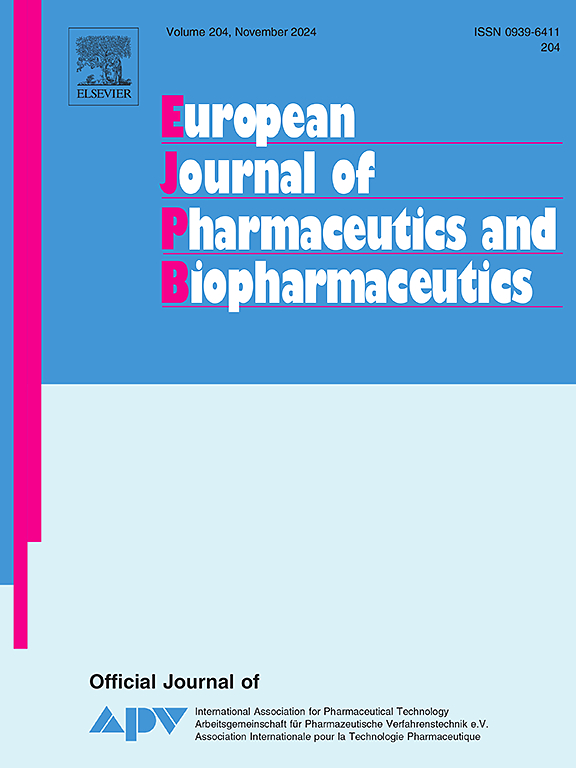Enhancing blending efficiency and in vitro aerosol performance of low-dose inhalable dry powders with spray freeze dried microparticles
IF 4.4
2区 医学
Q1 PHARMACOLOGY & PHARMACY
European Journal of Pharmaceutics and Biopharmaceutics
Pub Date : 2025-05-08
DOI:10.1016/j.ejpb.2025.114740
引用次数: 0
Abstract
Carrier-based dry powder inhaler (DPI) products deliver low-dose drugs to the lungs by blending micronized drug particles with carriers. Traditional methods for obtaining fine particles, such as milling or spray drying, are not suitable for high-value, heat-sensitive drugs. Hence, we propose a novel strategy for preparing carrier-based DPI products based on spray freeze dried (SFD) particles. Due to their spherical, porous, and brittle structure, they can be easily fragmented and uniformly attached to carriers under mild blending conditions. Additionally, these low-density fragments can detach from the carrier during inhalation, potentially achieving better pulmonary delivery performance. In this work, previously developed SFD ciprofloxacin/leucine particles were chosen as model particles, and commonly used lactose as carriers, then blended via TURBULA® T2F. The effects of model particle mass content, mechanical strength, carrier size distribution, blending time, and blending speed on both blending uniformity and in vitro aerosol performance were investigated. An image analysis method based on energy dispersive spectroscopy mapping images was proposed to rapidly determine blending uniformity, showing good correlation with concentration quantification methods. Optimized formulation (SFD-C1, 3.6 % mass content) and process parameters (blending speed of 25 rpm for 10 min) render excellent blending uniformity and fine particle fraction (∼ 50.40 %). This strategy potentially expands the application field of carrier-based DPI products.

用喷雾冷冻干燥微粒提高低剂量可吸入干粉的混合效率和体外气溶胶性能
基于载体的干粉吸入器(DPI)产品通过将微粉药物颗粒与载体混合,将低剂量药物输送到肺部。传统的获得细颗粒的方法,如碾磨或喷雾干燥,不适合高价值的热敏性药物。因此,我们提出了一种基于喷雾冷冻干燥(SFD)颗粒制备载体DPI产品的新策略。由于它们的球形、多孔和脆性结构,在温和的混合条件下,它们很容易破碎并均匀地附着在载体上。此外,这些低密度碎片可以在吸入过程中与载体分离,潜在地实现更好的肺输送性能。本研究选择先前开发的SFD环丙沙星/亮氨酸颗粒作为模型颗粒,以常用的乳糖为载体,通过TURBULA®T2F进行混合。研究了模型颗粒质量含量、机械强度、载体粒径分布、共混时间和共混速度对共混均匀性和体外气溶胶性能的影响。提出了一种基于能量色散光谱映射图像的图像分析方法,快速确定混合均匀性,与浓度定量方法具有良好的相关性。优化的配方(SFD-C1,质量含量3.6%)和工艺参数(混合速度为25转/分钟,混合10分钟)使混合均匀性和细颗粒分数(约50.40%)优异。这一策略有可能拓展基于运营商的DPI产品的应用领域。
本文章由计算机程序翻译,如有差异,请以英文原文为准。
求助全文
约1分钟内获得全文
求助全文
来源期刊
CiteScore
8.80
自引率
4.10%
发文量
211
审稿时长
36 days
期刊介绍:
The European Journal of Pharmaceutics and Biopharmaceutics provides a medium for the publication of novel, innovative and hypothesis-driven research from the areas of Pharmaceutics and Biopharmaceutics.
Topics covered include for example:
Design and development of drug delivery systems for pharmaceuticals and biopharmaceuticals (small molecules, proteins, nucleic acids)
Aspects of manufacturing process design
Biomedical aspects of drug product design
Strategies and formulations for controlled drug transport across biological barriers
Physicochemical aspects of drug product development
Novel excipients for drug product design
Drug delivery and controlled release systems for systemic and local applications
Nanomaterials for therapeutic and diagnostic purposes
Advanced therapy medicinal products
Medical devices supporting a distinct pharmacological effect.

 求助内容:
求助内容: 应助结果提醒方式:
应助结果提醒方式:


